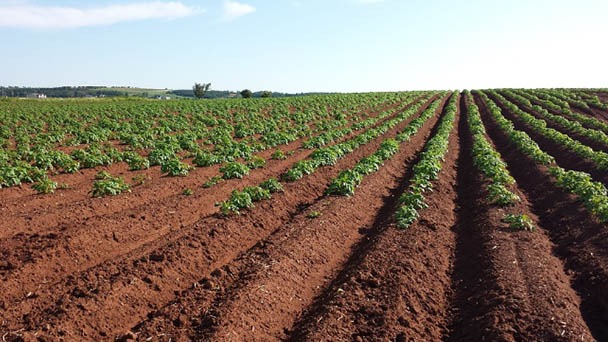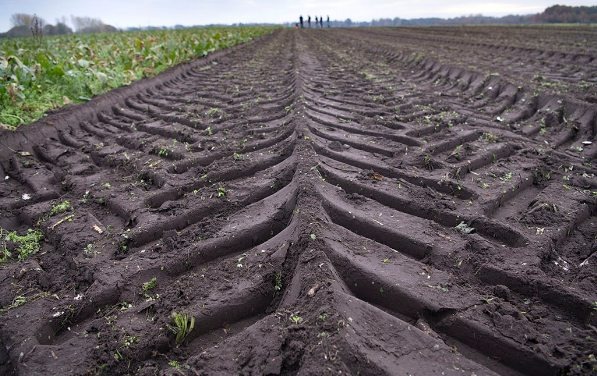What is Soil Compaction - How to Reduce in 2023
Written by Ivy
Dec 28 2022

Compression of soil pores, which would otherwise transport water and air, is the result of compaction. This prevents root development and may result in an oxygen shortage. A significant reduction in yield may result from compacted soil.
By definition, soil compaction refers to the process of compressing soil, which causes the soil to become denser. Consequently, the soil becomes denser and each litre of soil weighs more when the pores are compressed. Often, observing a tractor tyre roll over loose soil in wet conditions makes it simple to comprehend and assess the effects of soil compaction.
What is Soil Compaction?
When soil particles are packed too closely together, pore space is reduced, which reduces air and water flow efficiency. This condition is known as soil compaction. Your crops may become starved if your soil is compacted because this prevents proper nutrient absorption and root development. The use of large machinery, an abundance of soil moisture, foot traffic, and climatic change are just a few of the factors that can cause soil compaction.
The two main types of soil compaction are as follows. Contact pressure that compresses the top layer of your soil surface is what causes topsoil compaction. Usually, heavy equipment with high axle loads compacts the topsoil to such an extent that the unfavorable conditions spread to the deeper soil levels. Years of crop yields can be impacted by even a small amount of subsoil compaction.
6 Causes of Soil Compaction
The following causes, among others, can have an impact on how severe soil compaction is.
- Soil profile: Dry soils can support a considerable amount of weight. Wet or clayey soils tend to have fewer voids and compact more readily than dry soils. More compaction and a denser soil volume are natural characteristics of some soil types, such as sandy or loamy soils. In the absence of appropriate farming techniques or drainage procedures, these soils are likely to experience compaction more frequently.
- Poor drainage: Severe compaction is more likely to occur in overwatered, wet soils with poor aeration and low porosity. Your plant roots will be able to absorb nutrients more efficiently when water is able to permeate the soil properly. Overwatering or standing water on compacted topsoil can cause the moisture content of the soil to rise too high. Your crops may become starved as a result of the unfavorable soil conditions created by this.
- Thatch buildup: Thatch is a buildup of living and dead stems, roots, and rhizomes that surrounds your grass. The process of building up thatch on your lawn is not the same as mulching your soil with organic matter; in fact, it may worsen topsoil compaction. As a result, less air and water can reach the soil beneath your lawn as a result of thatch buildup.
- Foot traffic: Compacted topsoil can result from both livestock grazing and high human foot traffic. This lessens soil permeability and increases soil density, eventually resulting in nutrient and air penetration resistance that may impede crop production and plant growth.
- Field operations: Wheel traffic from deep tillage and over-plowing operations can weaken the soil and exacerbate compaction. Heavy machinery's running tires exert pressure on the ground, further compacting the soil. (You may have observed that crops hardly ever grow near extensive wheel tracks.) Plowing, ground treatments, and repeated soil tillage operations all destroy the aggregates that hold the soil particles together. This may throw off the soil's natural balance, which could result in severe subsoil compaction.
- Climate change: Compaction of the soil can also be a result of global warming and climate change. The soil becomes unbalanced as soil temperatures and/or nutrient availability vary, causing clumping, soil erosion, leaching, or other irregularities that allow for further compacting.
4 Effects of Soil Compaction
Poor growing conditions and environmental damage are both consequences of compacted soil. These are a few typical outcomes of soil compaction.
- Poor aeration: Lack of adequate aeration leads to increased soil compaction, which in turn can contribute to a lack of adequate aeration. Watering non-aerating soil can make it denser, which will starve the roots of your plant by causing soil particles to clump together.
- Pests and diseases: For pests and diseases, compacted soil makes an ideal breeding ground. The nutrients required to control specific bacteria and organisms in waterlogged, compacted soil are lacking, which can cause root rot and sick plants.
- Poor crop yield: Due to the limited space for root development caused by the compacted soil, plants may experience consistently poor crop growth and yields season after season. Poor root development also hinders a plant's ability to absorb nutrients, which can result in underwhelming crop yields.
- Flooding: Because the excess water content cannot properly permeate the soil, areas with severely compacted soils are more likely to experience runoff or flooding. Due to soil erosion, this may result in further structural damage as well as agricultural harm.

How to Reduce Soil Compaction
You can reduce soil compaction in your crops by doing a few different things. Although topsoil is typically easier to loosen, subsoil compaction is much more challenging to address. Take precautions to reduce the danger of deeply compacted soil. See below for some tips on how to help reduce soil compaction in your lawn or garden:
- Use perlite or vermiculite. You can encourage granular soil aeration and water infiltration by mixing perlite and vermiculite into the compacted layer of your soil. In soil mixtures for other drought-tolerant plants as well as for cacti, perlite is frequently present. To create space between soil particles and retain moisture, vermiculite flakes are mined and heated at high temperatures until they take on the appearance of worms.
- Use no-till soils. No-till soils have a higher level of biological activity than soils that have been used or treated repeatedly, which can naturally help prevent your soil from becoming compacted. No-till soils have a higher percentage of soil aggregates and are linked to less runoff and erosion, which can shield the sublayers from severe compaction.
- Avoid working with wet soils. Wet soils cannot support the weight of machinery as well as dry soils can. It's also possible that equipment with wider wheels and better weight distribution won't compact the soil as much.
- Check your soil regularly. The soil's resistance and moisture content should be periodically checked using a penetrometer. Which techniques you use to treat your ground soil will depend on how compacted it already is.
- Add soil organic matter. Your soil's bulk density can be decreased by adding organic matter, which also encourages healthy microbial activity. You can also add more nutrients and create space between the soil particles by sprinkling manure or compost on your soil. You can also aid in separating your soil's particles by incorporating earthworms.
Roots Impeded
Soil compaction results in root growth being restricted and affects mechanical resistance to root development in two ways:
- Large pores, or macropores, are reduced in number and size by compaction. As a result, there are fewer pores with diameter larger than roots in which the roots can grow freely, without mechanical resistance
- Compaction increases the mechanical resistance of the soil through pressing soil particles more closely together
Water Transport Restricted
Additionally, soil compaction limits how far down into the soil water can travel. According to the above image, this results in water saturation in the upper layers, which can then cause the roots to lack oxygen. Additionally, the level of soil aeration influences the accessibility of different plant nutrients, such as nitrogen and manganese. Denitrification can cause a significant loss of nitrogen to the atmosphere under anaerobic conditions, either as nitrogen gas or nitrogen oxide. Thus, soil compaction can reduce the amount of nitrogen available in the soil.
Possible Remedial Measures
It's crucial to use corrective actions that, over time, can improve soil structure to prevent soil compaction. These precautions include drainage, structure liming, maintaining vegetation cover over the soil, and providing organic material from outside. By making the soil drier, these actions lessen soil compaction at depth.
For soil compaction, cropping practices and tillage are also essential. Avoiding tillage when the soil is too wet is the most significant factor. While a wet soil is compressed under a similar pressure, a dry soil can support more weight. A larger contact area produced by wide tires or dual wheels reduces wheel load. The number of passes, as indicated by the results in the image below, and minimizing the overall weight of the field equipment are both crucial.
The effect of soil compaction prior to spring sowing on the yield of various crops (barley, wheat, oats, sugar beet, and peas) was investigated in a trial (L2-7118) at Önnestad, Skåne, in 2000. The compaction consisted of different numbers of passes with a heavy load over the field before sowing:
- Sowing without compaction
- One pass + sowing
- One pass with a slurry tanker + sowing
- Three passes with a slurry tanker + sowing
The outcomes demonstrated that some compaction, or tamping down, had a positive impact on spring wheat, barley, and oat yield. one pass + sowing. However, even with this treatment, yield was still reduced in sugar beet and peas. The yield of all crops decreased as the number of passes and consequently the degree of soil compaction increased. Peas, which are extremely sensitive to oxygen shortage, were the crop that was most adversely affected.
FAQs
What Are the Types of Soil Compaction?
The method of compaction is primarily of four types such as kneading, static, dynamic or impact and vibratory compaction.
What Causes Soil Compaction?
The most relevant human-induced causes of soil compaction in agriculture are the use of heavy machineries, tillage practice itself, inappropriate choice of tillage systems, as well as livestock trampling. Compaction of the topsoil and subsoil is a frequent result of the use of large, heavy machinery in agriculture.
Why is Soil Compaction Bad?
Soil compaction can lead to: poor root growth—which reduces crop yield through poor water and nutrient uptake. difficulties with soil cultivation and seedbed preparation. a decrease in water entering the soil either as rain or irrigation.
Latest Updated
- Benefits of Bugleweed - 7 Science-backed Health Benefits
- Bugleweed Dangers & Side Effects - Is It Poisonous?
- How to Plant Evergreen Trees - What You Should Know
- When to Plant Evergreens - Grow Guide for Evergreen Trees
- 12 Wonderful Evergreen Shrubs for Your Garden
- 12 Popular Evergreen Plants with Pictures for Beginners
- When And How To Prune A Lilac Bush Like a Pro
- How to Grow & Care for Lilac Vine (Hardenbergia Violacea)
- Japanese Lilac Tree (Syringa Reticulata) Care & Propagation Guide
- Shumard Oak Pros and Cons - What to Know
Popular Articles
- Winter maintenance of Antirrhinum Majus
- How to Grow Terminalia Mantaly Tree
- How to Grow and Care for Crossostephium Chinense
- How to grow Antirrhinum Majus in spring
- Peristeria Elata (Dove Orchid) Profile: Info & Care Guide
- Underwatered Snake Plant (Sansevieria Trifasciata) - Signs And How To Fix
- How to Care for Brazilian Jasmine Plant (Mandevilla Sanderi)
- How to Grow & Care for Graptopetalum Purple Delight in Summer
- Rosa Chinensis (China Rose): Plant Growing & Care Tips
- How to Care for Baby Sun Rose (Aptenia Cordifolia)